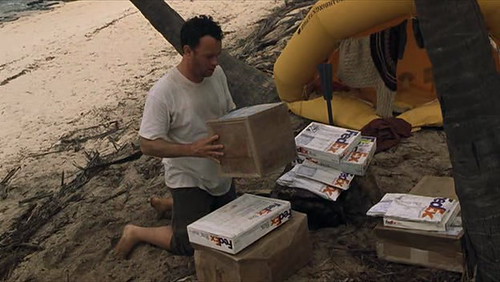In my first post on Brands&Films I’ve written that there are three classic types of product placement. A product or brand can be visible, used or someone can mention it. But in the year 2000 we had an excellent example of a fourth type: a brand became the character.
In 2000 Tom Hanks collaborated for the second time with director Robert Zemeckis in what was one of the most interesting stories about crashing to a deserted island. The movie Cast Away was acclaimed by critics and at the same time a box-office success. At the time of movie production Hanks was one of the hottest names in Hollywood. He was capable of being the lone character and the movie would still succeed. And that happened in Cast Away. For a large period he was on screen alone. He even gained fifty pounds during pre-production to make him look like a chubby, middle-aged man.
Just to remind you: in Cast Away Tom Hanks is Chuck, a FedEx employee who is stranded on an uninhabited island after FedEx’s plane crashes on a flight over the South Pacific. The film shows his attempts to survive on the island using leftovers of his plane’s cargo, as well as his eventual escape and return to society.

However, he was not alone on the island. Somehow he got company … from the unlikeliest source. When he opened boxes from the plane, he found Wilson volleyball. That ball eventually became “Wilson”, Chuck’s only company on the island. Apparently Wilson and FedEx, the other prominent brand that had a significant part in the movie, didn’t pay for product placement. I’ll analyse FedEx’s placement soon, but let’s check some interesting facts about Wilson.
According to Wikipedia Wilson was created by screenwriter William Broyles Jr. While researching for the film Cast Away, he consulted with professional survival experts and then deliberately stranded himself on an isolated beach for one week, thus forcing himself to search for water and food, and obtain his own shelter. During this time, a volleyball washed up on shore, inspiring him to add to the script one of its most creative elements: Chuck’s inanimate companion, Wilson.

This product placement is very interesting for one particular reason: product was not just visible and used, and Chuck didn’t just speak about it – the product became a character. It “listened” and provided company to Chuck. It became his unlikely friend. The additional data that is below the text show that Hanks was probably the most important Hollywood actor of the 90s. He was Forrest Gump, had AIDS, saved private Ryan, and in Cast Away he got a volleyball for a co-star. But he pulled it off.
Michael L. Maynard and Megan Scala calculated the costs that Wilson Sporting Goods Company would have to pay to advertise their product in the film. They included the number of people that viewed the film (approximately 100 million people have seen the movie in movie theatres, on home video and television), the number of times that the name “Wilson” was spoken by the protagonist (34 times according to Riku Kaijansinkko) and the number of times that the Wilson volleyball appeared in a scene. As a result, Maynard and Scala concluded that it would have cost the sporting goods company between $1.85 million to $11.5 million in advertising dollars.
The whole point of product placement is to present a brand to the viewer but in a way that does not cause the viewer to inquire as to why the product is there. There are two modes of message presentation —a subtle mode and an overt mode. As the Wilson volleyball transformed into a character during the movie, it went from low involvement to high involvement within the film. And according to Maynard and Scala that creates (and increases) brand awareness.

As a result of product placement Wilson Sporting Goods Company created a promotional ball, complete with the facial markings as seen in the film. The company obviously reaped the benefits from the emotional connection that consumers made with the volleyball resulting in a desire to own the product. In 2011 you can still buy Wilson Castaway Volleyball from Amazon or Target.
In my opinion Wilson in Cast Away is THE best product placement ever. Even if it happened coincidentally, if was perfect. Hanks’ and Wilson’s relationship was genuine and as a viewer I perceived Wilson as a character, not some branded product.
By the way, have you ever seen a serious, Oscar potential movie with a product as a character? It’s very hard to achieve that kind of collaboration. From a brand’s point of view that’s even better than highly visible placement or heavy usage. And in case of Wilson it was for free.
———————
Additional data:
At the end of June 1993 the movie Sleepless in Seattle premiered in the USA. It was the fifth highest grossing movie in the USA in that year and eight worldwide. It was also the first proper global success for 37-year old Tom Hanks and the beginning of a brilliant 10-year period.
The period which span from summer 1993 to the summer of 2003 included box office hits such as Forrest Gump, Cast Away, Saving Private Ryan, Apollo 13 … In that time Tom Hanks starred in 13 movies, which grosses 4.7 billion dollars worldwide. They received 59 Oscar nominations and won 16. Tom Hanks was nominated four times for best actor and won in 1994 for Philadelphia and in 1995 for Forrest Gump.
So, is Tom Hanks really the most important Hollywood actor of the 90s?

Sources used in the text:
Product Placement in Integrated Marketing Communications Strategy by Riku Kaijansinkko
Unpaid Advertising: A Case of Wilson the Volleyball in ‘Castaway’ by Michael L Maynard and Megan Scala


It really make a sense. Very nice article. Thanks for sharing your blog. keep blogging!
——————–
best regards,
Katherine Lee
Thanks.
Erik